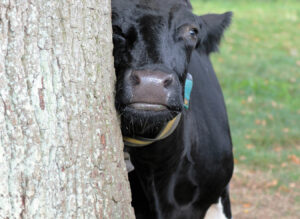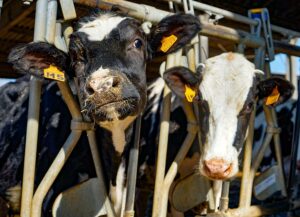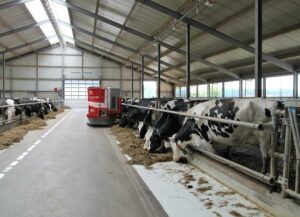Álvaro García
In my early days consulting with diaries in South America, one of the most common calf rearing systems was known as the “Ternestaca” (compound name of ternero (calf) and estaca (stake). The concept was simple but practical: each calf was tethered to a stake in the ground, with access to two rings welded to the stake that will hold a bucket, one for milk (later water) the other for grain. The system allowed calves to be moved daily to a clean patch, reducing the risk of pathogens, or could be positioned under a tree shade during hot days to keep them comfortable.
It was an efficient method for its time, balancing hygiene, labor, and calf comfort. In fact, it is still in use on small family farms. However, what we did not realize at the time was that we were missing a critical component of their development, the benefits of close-contact socialization. We now know calves reared with social close contact, show improved feed intake, faster adaptation to solid feed, better weight gains, and even stronger immune responses. Close social interaction encourages natural behaviors such as grooming, play, and synchronized feeding, which not only improve well-being but also performance.
The neonate calf
The early rearing period is critical for establishing health, growth, and behavioral development in dairy calves. Historically, individual housing has been the standard approach, aimed at reducing disease transmission and simplifying feeding management. However, evolving perspectives on behavioral needs have driven interest in more social interaction, which provides opportunities for calves to engage in natural behaviors such as play, grooming, and synchronous feeding.
Pair housing has emerged as a practical compromise between individual and group housing. It offers the social and behavioral benefits of peer contact while avoiding some of the elevated disease risks seen in large group pens. Studies have linked social housing with improved adaptability to new feeds, greater feed intake, and increased weight gain, especially around weaning. However, performance results have varied, suggesting that other factors, such as milk feeding amounts, age at pairing, and environmental conditions, may influence outcomes.
Seasonal climate may play a key role in modulating these benefits. Cold stress can increase maintenance energy needs, while heat stress can depress feed intake and immune function. Social housing may buffer cold stress through shared warmth and coordinated rest, but during heat stress, close contact might either help maintain feeding motivation or worsen thermal load.
Recent experiment
An experiment published in 2025, conducted at the University of Florida compared growth, feed intake, health, and activity of pair‑housed and individually housed calves in both cool and warm seasonal conditions in the subtropical climate of the state. Calves received 4.5 L of high‑quality colostrum (Brix >25%) within 4 hours of birth through an esophageal feeder. Calves born between May and August received a second 2.3‑L feeding within 24 hours. By the third day of age, they were assigned to either individual pens (IH; 0.9 × 1.8 m) or pair pens (PH; 1.8 × 1.8 m) and located under an open‑sided barn with sand bedding, shade, and overhead fans.
Just a bit of historical context: back in the 1980s, an “adequate protein” calf starter typically contained 16–18% crude protein (CP), and milk replacers were formulated with 18–20% CP and considerably less fat than what we use today. At that time, it was also common practice to feed dairy calves around 4 liters (roughly 1 gallon) of milk or milk replacer per day, usually divided into two 2-liter feedings.
To give a broader perspective, since the 1980s, mature Holstein cows have increased in size — from approximately 450–540 kg to about 700 kg, and average birth weights have risen from 35–40 kg to 40–45 kg. This increase in body size has naturally led to greater nutrient demands, prompting a shift toward higher milk replacer intake (now 6–8 L/day) and increased starter consumption. Feeding programs have evolved to support this growth, prioritizing improved feed efficiency and accelerated early development. Back then, feeding strategies were often designed to restrict milk intake, deliberately encouraging early starter consumption under the belief that it would accelerate rumen development, even at the cost of slower growth in the early weeks. In hindsight, this approach unintentionally constrained calf growth and, by extension, future milk production potential.
Today, the contrast is striking. In this recent Florida study, calves were fed a starter containing 22% CP, 28% NDF, and 38% NFC, alongside a high-nutrient milk replacer with 28% CP and 20% fat, offered at a generous 8 L/day in two teat-bucket feedings. Modern rations are carefully designed not just to support maintenance and growth but to unlock genetic potential for high lifetime productivity, while also promoting immune function, rumen development, and overall calf health — priorities that were scarcely imagined four decades ago.
In the study, weaning began between days 43 and 46 and was carried out gradually over 10 days by tapering milk volume (6 L/day for 4 days, 4 L/day for 4 days, then 2 L/day for 2 days). At week 8, calves transitioned into group pens (4–5 calves per pen), and data collection concluded with a final body weight measurement at week 9.
Seasons were defined as:
- Cool: mid‑October to mid‑April (mean 16.9 ± 5.2°C; occasional lows <10°C).
- Warm: mid‑April to mid‑October (mean 25.6 ± 3.0°C; THI consistently >65).
Measurements and key findings
Calf health was assessed five days per week, tracking fever incidence (≥39.4°C) and scours (fecal scores 2–3). Starter intake was recorded four days per week at the pen level, converted to a dry matter basis. Growth was monitored through body weights taken at birth, start and end of weaning, and one-week postweaning, with average daily gain (ADG) calculated for each period. Activity was evaluated using leg‑mounted accelerometers to measure total daily standing time and hourly standing patterns.
Health outcomes were comparable between treatments, but seasonal effects were evident. In the cool season, fewer pair‑housed (PH) calves experienced fever than individually housed (IH) calves. Warm‑season calves developed scours earlier, endured longer bouts, and showed higher fever rates. Starter intake advantages for PH calves emerged by week 5 preweaning and persisted through weaning. There was a strong seasonal interaction: in the cool season, PH calves consumed an additional 0.17 kg/day of starter during weaning; in the warm season, intake differences were negligible. Growth followed a similar pattern, PH calves reached higher body weights by the end of weaning and one week later, with the largest ADG advantage during the cool‑season weaning period (+0.35 kg/day over IH). In the warm season, growth benefits were smaller and not statistically significant postweaning. Activity patterns revealed that PH calves stood longer each day, especially in the late afternoon and evening. Notably, evening activity peaks occurred later in the warm season, coinciding with later sunset and cooler evening temperature‑humidity index values.
Implications
This study confirms that pair housing benefits calf performance, particularly under cooler conditions. The increased starter intake and growth observed in PH calves align with previous reports linking social housing to greater feeding motivation and feed exploration. When calves are housed with another, they don’t just eat because they’re hungry, they also eat because the other calf is eating. This is called social facilitation: one animal’s behavior sparks the same behavior in another.
On top of that, calves tend to synchronize what they do. If one is lying down, the other is often lying down as well; if one starts nibbling on starter, the other is suddenly interested in nibbling too. So instead of a calf cautiously trying feed here and there on its own, you get two calves exploring together, tasting together, and learning faster that the feed is worth eating. The result is that they start eating solid feed earlier, eat more of it, and grow faster, not because the feed has changed, but because they have a partner showing them the way, and even competing for the food.
With cool weather, two calves housed together can help each other keep warm. This is called “social thermoregulation”, they share body heat when lying near each other. That means they spend less energy trying to stay warm (like shivering), leaving more energy for growth. This could explain why pair housing seemed to work even better in cooler months.
When the atmosphere is hot, things change. Heat stress often makes calves eat less, no matter how friendly they are with each other. This loss of appetite can erase the feeding boost they normally get from being housed together. Plus, in warm weather, calves tend to stand more, a natural cooling behavior in cattle, but standing takes more energy than lying down. So while they may still get along well, their bodies are busy coping with heat rather than using energy efficiently for growth.
Health was not negatively affected by pair housing, and some indicators (e.g., lower fever incidence in the cool season) hinted at potential health benefits. These results should reassure producers concerned about increased disease risk from social housing when calves are managed under good hygiene and ventilation.
In summary, pair housing from birth improved feed intake, growth, and activity without compromising health. Benefits were most evident during cooler seasons, when social contact may help calves conserve energy for growth. In warmer conditions, the performance gap between housing systems was smaller, likely due to the overriding effects of heat stress. Pair housing thus represents a practical, well-being approach that can enhance performance, particularly in temperate or cool climates, when combined with good calf management practices.
The full list of references used in this article is available upon request.
© 2025 Dellait Knowledge Center. All Rights Reserved.









